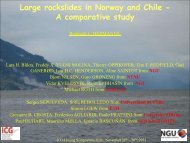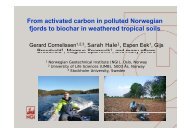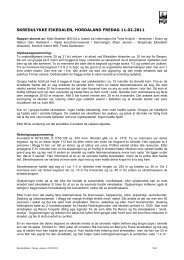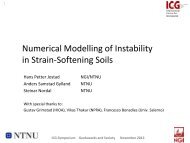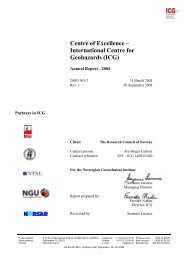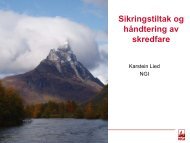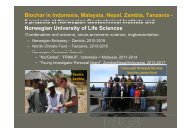944 M. Lato et al.: Using mobile terrestrial LiDAR for <strong>rockfall</strong> hazard analysisFig. 15. Volumetric change detection by comparison <strong>of</strong> successive scans in time from a similar location. Identified zones represent between5 and 10 cm <strong>of</strong> movement or release <strong>of</strong> rock blocks.5 DiscussionThe examples illustrated in this paper outline the use <strong>of</strong> mobileterrestrial and static LiDAR in comparison to traditionalfieldwork completed by an experienced engineer. The dataused in these analyses were from three sources: airborne,mobile terrestrial – TITAN, and high-resolution static equipment– Leica HDS 6000. The examples described involvethe use <strong>of</strong> advanced technology, processing tools, and computationalpower. Through the use <strong>of</strong> these tools, many advantages<strong>of</strong> using LiDAR are readily identified.Other engineering applications <strong>of</strong> mobile terrestrial Li-DAR fused with airborne LiDAR are <strong>rockfall</strong> modelling andviewshed analyses. Rockfall models can be used to statisticallyevaluate potential <strong>rockfall</strong> paths and final positions.Traditional 2-D models are limited to a single possible pr<strong>of</strong>ile<strong>of</strong> movement. 3-D models enable direct interaction <strong>of</strong> thefalling rock with detailed topography, as illustrated by Lan etal. (2007).Viewshed analyses enable the visible distance to be calculatedfrom a known location, the potential visibility iscontrolled by topography. The quality <strong>of</strong> the topographicdata used for this analysis in terms <strong>of</strong> density, accuracy, andcoverage directly influence the result. The calculated visibilitycan be used to directly calculate stopping distances.As workflows develop that incorporate the use <strong>of</strong> LiDARdata, regardless <strong>of</strong> the source, it will be critical that automation<strong>of</strong> feature extraction evolve as well. There needs to bebetter integration with GIS and CAD based programs. Aswell, data visualization would greatly benefit from the abilityto colour the point cloud based on high-resolution photography.As the price <strong>of</strong> LiDAR data collection decreases, positioningsystems become more accurate, and processing tools becomeeasier to use, the incorporation <strong>of</strong> mobile terrestrialLiDAR scanning into active rail usage will be a part <strong>of</strong> thegeneral workflow. If trains are equipped with LiDAR scanners,real-time differential models could be generated as thetrain drives the rail line. This would generate a real-timehazard map identifying locations <strong>of</strong> mass-movement or therelease <strong>of</strong> rock blocks.The key to this work is not to speed up the operationalprocess <strong>of</strong> identifying <strong>hazards</strong> but to increase the safety,accuracy, and repeatability <strong>of</strong> their identification by usingnew state-<strong>of</strong>-the-art tools. For example geo-simulation toolssuch as Train-MAGS (Mekni et al., 2008) can be used toNat. Hazards Earth Syst. Sci., 9, 935–946, 2009www.nat-<strong>hazards</strong>-earth-syst-sci.net/9/935/2009/
M. Lato et al.: Using mobile terrestrial LiDAR for <strong>rockfall</strong> hazard analysis 945dynamically calculate maximum train speed based on stoppingdistance. The most powerful and useful advantages are:data fusion, feature extraction, differential <strong>monitoring</strong>, <strong>rockfall</strong>analysis, and viewshed analysis.6 ConclusionsThe ability to use LiDAR data to identify and examinegeomechanically controlled structural features has beendemonstrated and proven for many applications. However,the innovative use <strong>of</strong> mobile terrestrial LiDAR forsuch applications demonstrates significant advantages overtraditionally employed static terrestrial LiDAR includingcoverage, rate <strong>of</strong> acquisition, dynamic collection, and integrationwith corridor operation. Mobile terrestrial LiDAR isan evolving technology and the combination <strong>of</strong> tools availableto extract and analyze features within the data are alsoevolving. The examples in the paper and those being researchedby others will prove to be a cornerstone for a newdirection with respect to geomechanical feature identification,especially for sites in remote areas and those <strong>along</strong> active<strong>transportation</strong> corridors.Acknowledgements. The authors would like to thank TransportCanada, GEOIDE, NSERC, and the OCE for research funding.CN Rail provided track access and personnel during scanning.Edited by: M.-H. DerronReviewed by: S. Buckley and another anonymous refereeReferencesAbbott, B., Bruce, I., Keegan, T., Oboni, F., and, Savigny, W.: AMethodology for the Assessment <strong>of</strong> Rockfall Hazard and RiskAlong Linear Transportation Corridors, 8th Congress, InternationalAssoc. Of <strong>Engineering</strong> Geology, A Global View fromthe Pacific Rim, Vancouver: Balkema, A. A.,Vancouver, BritishColumbia, 2, 1195–1200, 1998.Alshawa, M., Smigiel, E., Grussenmeyer, P., and Landes, T.: Integration<strong>of</strong> a terrestrial LiDAR on a mobile mapping platform:first experiences, 5th International Symposium on Mobile MappingTechnology, Italy, p. 6, 2007.Barber, D., Mills, J., and Smith-Voysey, S.: Geometric validation<strong>of</strong> a ground-based mobile laser scanning system, Journal <strong>of</strong> Photogrammetryand Remote Sensing, 63, 128–141, 2008.Buckley, S. J., Howell, J. A., Enge, H. D., and Kurz, T. H.: Terrestriallaser scanning in geology: data acquisition, processing andaccuracy considerations, J. Geol. Soc. London, 165, 625–638,2008.Donovan, J. and Raza, A. W.: A change detection method for slope<strong>monitoring</strong> and identification <strong>of</strong> potential <strong>rockfall</strong> using threedimensionalimaging, San Francisco, American Rock MechanicsAssociation, X., 2008.El-Rabbany, A.: Norwood: Artech House Publishers, Introductionto GPS: The Global Positioning System., 2nd Edition , 2006.ESRI: ArcGIS V9.3 (Build 1770), Redlands, Ca. USA, 2008Feng, Q. and Rosh<strong>of</strong>f, K.: In situ mapping and documentation <strong>of</strong>rock fases using a full-coverage 3-D laser scanning technique,Paper 1A 23, CD-ROM, Int. J. Rock Mech. Min., 41(3), 379,2004.Glennie, C.: Reign <strong>of</strong> point clouds: a kinematic terrestrial LiDARscanning system, InsideGNSS, Fall 2007, 21–31, 2007a.Glennie, C.: Rigorous 3D error analysis <strong>of</strong> kinematic scanning Li-DAR systems, J. Appl. Geodesy, 1, 147–157, 2007b.Goodman, R. E.: Introduction to rock mechanicsm, edited by: Wiley,J., Toronto, Chapter 8, 1980.InnovMetric: PolyWorks V10.1, Quebec City, Qu., Canada, 2008.Lan, H., Martin, C. D., and Lim, C. H.: Rockfall Analyst: a GISextension for three-dimensional and spatially distributed <strong>rockfall</strong>hazard <strong>monitoring</strong>, Comput. Geosci., 33, 262–279, 2007.Lato, M., Hutchinson, D. J., Diederichs, M. S., and Harrap, R.:Optimization <strong>of</strong> LiDAR scanning and processing for automatedstructural evaluation <strong>of</strong> discontinuities in rockmasses, Int. J.Rock Mech. Min., 46, 194–199, 2009.Maerz, N. H.: Highway rock cut stability assessment in rockmassed not conducive to stability calculations, Proceedings <strong>of</strong>the 51st Annual Highway Geology Symposium, Seattle, Washington,249–259, 2000.Mason, D. C., Horritt, M. S., Hunter, N. M., and Bates, P. D.: Use<strong>of</strong> fused airborne scanning laser altimetry and digital map datafor urban flood modelling, Hydrol. Process., 21(11), 1436–1447,2007.McKean, J. and Roering, J.: Objective landlside detection and surfacemorphology mapping using high-resolustion airborne laseraltimetre, Geomorphology, 57, 331–351, 2004.Mekni, M., Sahli, N., and Moulin, B.: A geosimulation approachinvolving spatially-aware agents: A case study on the identification<strong>of</strong> risky areas for trains, SpringSim, 1-56555-319-5, 37–45,2008.Optech. Inc. , Lynx Mobile Mapper, Toronto, On. Canada 2008.Pritchard, M., Porter, M., Savigny, K. W., Bruce, I., Oboni, F.,Keegan, T., et al.: CN <strong>rockfall</strong> hazard risk management system:experience, enhancements, and future direction, The AmericanRailway <strong>Engineering</strong> and Maintenance-<strong>of</strong>-Way Association,Chicago, 2005.RocScience, Dips 5.1. Toronto, On. Canada, 2005.Rosser, N., Dunning, S., Lim, M., and Petley, D.: Terrestrial laserscanning for quantative <strong>rockfall</strong> hazard assessment, in: Landsliderisk management, edited by: Hunger, O., Fell, R., Couture, R.,Eberhardt, E., Rotterdam, Balkema, p. 091, 2005.Staley, D. M., Wasklewick, T. A., and Blaszcynski, J. S.: Surficialpatterns <strong>of</strong> debris flow deposition on alluvial fans in DeathValley, CA using airborne laser swath mapping data, Geomorphology,74(1–4), 152–163, 2005.Sturzenegger, M., Stead, D., Froese, C., Moreno, F., and Jaboyed<strong>of</strong>f,M.: Ground-based and airborne LiDAR for structural mapping<strong>of</strong> a large landslide: the Frank Slide, in: Proceedings <strong>of</strong> thefirst Canadian US rock mechanics symposium vol. 2, edited by:Eberhardt, E., Stead, D., and, Morrison, T., Vancouver, London,Taylor and Francis, 925–932, 2007a.Sturzenegger, M., Yan, M., Stead, D., and Elmo, D.: Applicationsand limitiations <strong>of</strong> ground-based laser scanning in rock slopecharacterization, in: Proceedings <strong>of</strong> the first Canadian US rockmechanics symposium vol. 1, edited by: Eberhardt, E., Stead, D.and, Morrison, T., London, Taylor and Francis, 29–36, 2007b.www.nat-<strong>hazards</strong>-earth-syst-sci.net/9/935/2009/ Nat. Hazards Earth Syst. Sci., 9, 935–946, 2009





